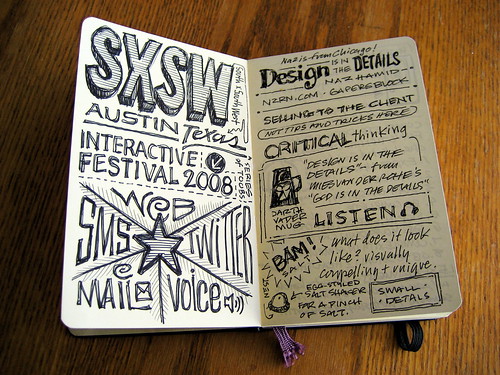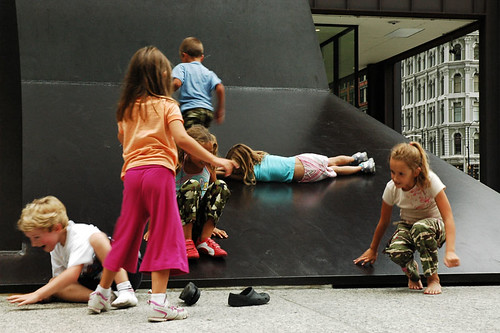
In the continuing visual thinking vein, take a look at Mike Rohde’s SXSW Sketchnotes AND, the gift he offers with his post, Lessons Learned from my SXSW Sketchnotes. Mike’s lessons from doing Moleskin notebook sketches to capture conference sessions and experiences, then sharing them freely on flickr… pulling out a few key quotes. Go read the whole article.
A Fast Spreading Meme
I’m fascinated at how quickly the sketchnotes spread across the net. On the Tweet scan and RSS searches for my name, “SXSW Sketchnotes” were popping up all over and being re-tweeted like crazy. [Nancy’s comments – we hunger for the visual]Readers Like Personal Accounts
…Sharing a unique, personal perspective is a powerful way to communicate. Sketchnotes are one way that attendees to the panels can re-live an experience…
[Nancy’s comments – we hunger for the personal]The Human Touch Attracts Readers
…They’re a little imperfect, yet very readable and understandable…
[Nancy’s comments – we hunger for something we can relate to – with comfort]Sketchnotes Awaken Memories
…Notes and sketches of my activities help me recall clear memories — even years after the trip…
[Nancy’s comments – well, as I age, I appreciate this even MORE]New Opportunities
I’ve been approached several times this week about doing “sketchnote” style illustrations for a couple of projects. ..
[Nancy’s comments – being open and generous pays off]Creative Commons Frees Up Images
All of the sketchnote scans and photos have been uploaded to Flickr with a Creative Commons non-commercial, attribution license, which frees people to place my images on their sites with attribution, and no need to ask permission. I love this!
[Nancy’s comments – so do I. THANKS!]
Image by Mike Rohde
 Yesterday I was interviewed about “making mistakes in public” and how that allows us to get feedback and learn from others. My friend Philip Tarlow mentioned this Picasso quote to me last week, and it struck me as being about our learning edges. Doing things we aren’t quite sure we know how to do. Taking risks in the name of learning and doing.
Yesterday I was interviewed about “making mistakes in public” and how that allows us to get feedback and learn from others. My friend Philip Tarlow mentioned this Picasso quote to me last week, and it struck me as being about our learning edges. Doing things we aren’t quite sure we know how to do. Taking risks in the name of learning and doing. I’m not in Austin for the perennial geek culture fest that is SXSW. But via Twitter and blogs, I’m getting some vibes all the way up here in the northland.
I’m not in Austin for the perennial geek culture fest that is SXSW. But via Twitter and blogs, I’m getting some vibes all the way up here in the northland. I blogged last week that David Sibbet and others were doing real time
I blogged last week that David Sibbet and others were doing real time  I’m fickle.
I’m fickle.